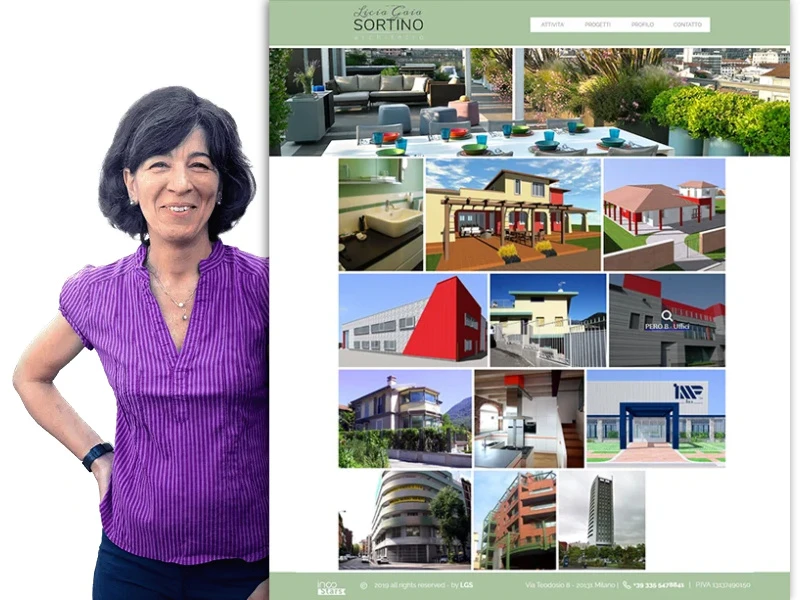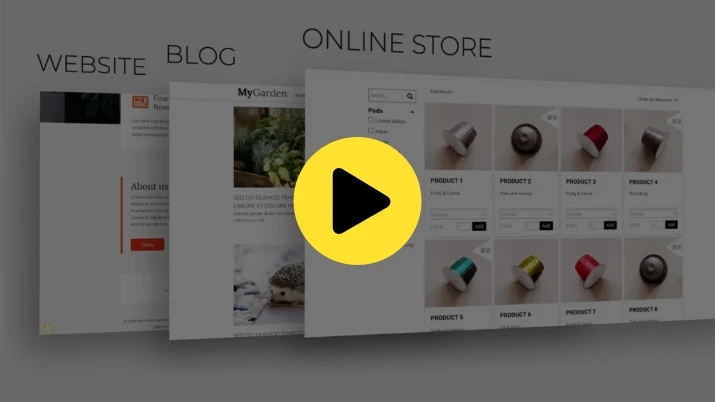Six practical tips for creating an architectural portfolio website
Published by Incomedia in Guides and Tips · Thursday 07 Sep 2023
Is there any profession these days for which it's not advantageous to introduce oneself via a website? The more I think about it, the more I'm convinced that the answer is no.


Any professional activity, however specialised and sector-specific, needs to reach its audience, introduce itself, tell its story and convince customers of the merits of its offerings. And, to do all this, a website is the perfect tool!
Architects are no exception. It makes no difference whether you're an established architect or an up-coming designer, whether you're a freelancer or have a studio you need an online portfolio site that showcases your work, allows you to acquire new clients and, consequently, allows you to grow your business.
If you follow our advice, your architectural portfolio website will not only serve as a compelling business card, it will also become an essential tool for growing your business.
1. Choose a smart domain name
As an architect, you can decide what a building will look like, but you can't really determine its address. Regarding your website, however, things are different. Not only can you choose your domain name and extension in order to define the URL where it'll be found, but you'll need to do it carefully since it has major implications.
Choosing a domain name is a fundamental step in building your digital identity as an architect.
The domain name is the part you'll find after the // in a website address as well as after the "@" in an e-mail address.
For example, in the URL https://www.websitex5.com/en/tutorial.php, the domain name is "websitex5.com".
The domain name will be used by all your potential clients and collaborators to find you online and can also affect the placement of your pages in search engines. Therefore, when choosing your domain name, be careful that it's:
- Easy to remember: A domain name that's short and easy to pronounce allows your visitors to remember it and type it easily into their browsers. For example, you can use your name or the name of your studio. This is what Santiago Calatrava (calatrava.com) or Massimiliano and Doriana Fuksas (fuksas.com) did.
- Easy to type: Avoid hyphens, numbers and special characters in your domain name as they could lead your visitors to make mistakes, making it difficult for them to reach you. The Renzo Piano Building Workshop, with a clear choice of branding, has simplified a long and complex name into a much simpler one with rpbw.com
- Capable of defining and positioning your business: You can include, perhaps next to your name, a keyword that defines your scope or is otherwise relevant. This helps users immediately understand the type of services you offer and, on the SEO side, allows search engines to better categorize your site. For example, stefanoboeriarchitetti.net.
- Paired with the appropriate extension: The extension (or TLD, Top Level Domain) is the ending suffix. If you work in Italy, you could opt for .it. Otherwise, you should consider .com. Remember that there are many other more specific extensions you can use if the domain you wanted is no longer available.
2. Choose a template that represents you
Like architects, those who work in a field where aesthetics and artistic tastes play a leading role, website graphics is an element that should never be overlooked. Anyone who enters your website must feel welcomed in a comfortable, well-kept and easy to navigate environment but above all, they must feel that they're in a space with a strong identity, characterised by your designs and your way of understanding architecture.
Templates are an important source of inspiration for creating a website that reflects your style.
You can choose to start with a template design or to use an empty template. In the first case, you have the advantage of saving time while, in the second case, you end up with a totally personalised solution.
In any case, try to convey the same style and taste for detail via the template that you infuse into your designs. Choose neutral and sophisticated color palettes that evoke the architectural environment. Choose fonts that make the text easy to read. Insert graphical elements such as lines, grids or geometric shapes to add a touch of design.
Remember that a good template isn’t just attractive from an aesthetic point of view, it also has to be functional. It should adapt to the structure of your site and highlight the most important elements: in this specific case, your portfolio of projects and contacts.
3. Put together a clear and functional structure
Like a building, a website also needs a solid structure to stand on.
Designing the site's structure means defining the sections and pages it should be divided in and how it all should be connected through a navigation menu.
A well-organized design is the best way to guarantee proper navigation of the site.
Generally, an architectural website doesn't need that many pages and, consequently, offers a fairly simple navigation that leads visitors to the content they're looking for in just a few clicks. The essential sections include:
- The home page
This is where you welcome your visitor. It needs to represent you and make it immediately clear who you are and what you offer, while being informational and exciting. This is where you get your chance to instantly make a good first impression. - Who we are
Don't underestimate the importance of this page. It offers you an opportunity to tell who you are, what your ideas and goals are and to explain why you might be a good fit. Try to create an emotional connection, perhaps "putting faces to names" with a photo of you and each member of your team. - Portfolio of projects
This is the heart of your entire website. It's where you really showcase who you are and what you can do. You need to be aware that through the projects you decide to showcase, you're providing a certain image of yourself and defining the expectations of your users. It's extremely important to choose wisely so we'll talk more about how to put together the best portfolio. - Contact information
One of the goals of your website is to find new clients, so give them a way to contact you. Your contact info, including your name, address, phone number and email address, should all be placed directly into the footer of the template, so it's always available and easy to find. Additionally, assemble them all on a contact page and perhaps complete it with an email form along with a map and directions on how to reach you.
In addition to these essential sections, there are others you might also consider adding (even if you're already online) that can give your architectural website an extra edge. These include:
- Acknowledgments, Awards and Publications
You can dedicate a page to each of these items or assemble them all on a single page. Talking about recognitions or awards you've received or the publications you're in consolidate your brand, establish authority and gain the trust of potential partners and clients. - Blogs
People love stories, and a blog gives you the opportunity to tell them. You can add the news concerning the studio, discuss the idea behind a new project or follow the progress on an ongoing construction site, etc. When you think about it, you have a lot to tell and share. This helps you connect with people and also helps you with Search Engine Optimization (SEO). - Online shop
Your website can be much more than a showcase; it can be a store where products are sold directly online. If, in addition to designing, you also produce or if you have digital products (for example, publications) that you can sell directly, why not do it online? - Work with us
A well-designed website makes you attractive, not only to possible clients, but also to new potential employees. You can use it to attract talent, collect applications and grow your business.
4. Carefully curate your portfolio
We've already mentioned that the portfolio in which your work is collected and displayed is the heart of an architectural website. Given its strategic importance, you'll need to carefully evaluate how to put it together, decide which work to include, which to exclude and how to present it.
First point- Don't get caught up in performance anxiety, and don't think that quantity is more important than quality.
It's NOT necessary (and may even be counterproductive) for you to include ALL the projects you've worked on. Use a critical eye and only select the best — those which really say something about you and highlight your strengths. A few great works are better than many lesser quality ones. Viewers will appreciate your work and the fact that you're not wasting their time.
Second point - Don't neglect the power of storytelling.
Make sure you provide concise descriptions and always explain the role you played. Highlight the client brief, the project purpose and the challenges, along with your solution in a clear and concise way. Remember that people looking at portfolio work are often more interested in understanding what the thought process was that led you to a result, rather than the result itself.
Third point - Focus on image quality.
Images of your projects are essential. For this, they must be of the highest quality. Invest in professional photographs that will showcase your portfolio. To make each project more interesting, combine the photographs with images of the 3D model, drawings, illustrations and original sketches. All of this will capture the attention and interest of your visitors.
Fourth point - Always keep your portfolio updated.
Mentioning this may seem unnecessary, but once you've assembled your portfolio and put it online, you need to remember to update it. Only by presenting and sharing your most recent projects can you demonstrate that you are active, that you work and have experience.
5. Make your website mobile-friendly
According to data from Statista, in 2022, mobile traffic represented 54.8% of total Internet traffic, overtaking desktop traffic. By 2023, it'll increase to 69.2%.

Percentage of mobile website traffic worldwide from Q1 2015 to Q4 2022 (Statista)
After all, we all spend a lot of time online, browsing, chatting, playing and doing a thousand other things through our mobile phones. Because of this, all websites should also be perfectly optimised for mobile navigation.
Your next client might access your site while on the train. You need to ensure that your web pages guarantee the same user experience as one would have surfing from a desktop computer in an office.
6. Optimize for SEO and drive traffic
When your site is ready in terms of graphics and content, you can begin feeling satisfied, but you shouldn't think you're finished yet! A good website, in fact, is a great starting point, but it's of little value if it receives no traffic.
There are various strategies you can implement to “push” your website. Some of the most important and effective include:
- Search engine optimization (SEO). SEO is a rather vast discipline whose goal is to position a site at the top of search results, thus attracting more visits and potential customers. You can begin by creating high-quality content for keywords relevant to your business, managing meta tags properly and building links from other relevant websites.
- Paid advertising. If you have the budget, a great way to drive traffic to your website is to advertise online for a fee. Running a campaign on Google, Facebook or Twitter, etc. isn't all that difficult and can provide good results especially if, thanks to the targeting options they offer, you manage to intercept an audience that's in line with what you're offering.
- Social media marketing. Sharing content on platforms like Instagram, Facebook, LinkedIn or Pinterest allows you to increase your visibility, introduce your work and, above all, engage and communicate with many people who could become new clients. In short, with a bit of strategy, social media platforms can be an excellent tool for promoting your brand and your services.
- Email marketing. Sending periodic newsletters in which you discuss projects you follow, architectural trends, events or providing design advice allows you to demonstrate your experience and to cultivate lasting relationships with existing and/or potential clients.
Of course, you don't have to adopt all these strategies, and it doesn't even mean that what has worked for others will work for you. It depends a lot on what your specific goals are, the budget you're willing to invest and the audience you're targeting. You should experiment until you find the mix of strategies that best suits your business and your goals.
Create your architectural website with WebSite X5
After these six excellent tips for creating an architectural portfolio website, all we have to do now is give you a good advice on the tool you can use to do it: Website X5 software.

Architect Licia Gaia Sortino chose WebSite X5 for her site. Read her story
With WebSite X5, creating a professional architectural website is an easy and intuitive process that's accessible even if you have no programming experience. All you have to do is follow the guided procedure that takes you, step by step, through customising the template, creating the pages, inserting your content, activating all the necessary functions and, finally, publishing your complete site online.
Find out in this short video how to start working with WebSite X5.
You'll have everything you need to create a professional website. Among other things, the following are particularly worth noting:
- Rich internal libraries of templates, images and icons
- Numerous possibilities for creating galleries, slideshows and portfolios
- Advanced functions for creating blogs, e-commerce areas, multilingual sites, pages protected by logins, e-mail forms, etc.
- Integration of an AI-based text generation assistant
- Included hosting service with automatic domain and free webspace for one year.
Beginning with one of the available templates, your architecture firm's website will be ready sooner than you can imagine and with a very limited investment of time and resources!
If you haven't already, download the trial version of WebSite X5. We're sure that also this project will give you great satisfaction!


